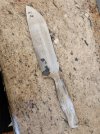Just a comment or two:
Leaf springs off that truck may be many alloys but are almost surely NOT 5160. You are OK to use 5160 as a range for forging temperatures and HT. 9260 would be a close guess. The 2% silicon makes it flex better and the 1% manganese makes it tougher.
The bright yellow is OK to start forging the leaf springs.
Greyish is way too cool for stopping. You should stop at medium/light red (well before dull red). The forging temperature range is start at 2100°F and stop at 1600°F.
You don't just pound on the steel with a hammer to make it thinner. You use the pein to draw it out. Work drawing at full heat and stop at cherry red. Youi won't do much drawing by hand below 1700°F. Once drawn out then forge the billet smoother and start shaping.
It is often easier to forge out oversize steel to the working thickness (about 125% of the desired thickness), then saw out the basic profile, and finally forge it to rough shape. Don't kill yourself trying to forge in every detail, do that in the filing and grinding stages.
Start with a reasonable size piece of steel. If you have 1/4"+ springs, start with about 6" to 8" of it. That will forge a large camp knife. A good set of U-Box tongs ( Z-Box tongs are even better) is the best way to hold the steel while working it out.
If you send me an email with your shipping address, and what size and type of knives you want to forge, I'll send you a box full of good known steel. Merry Christmas.

